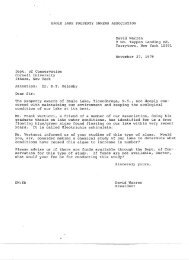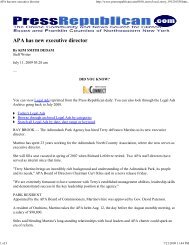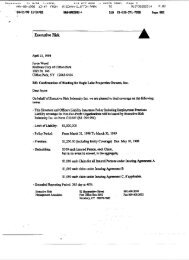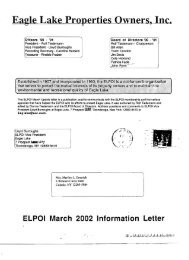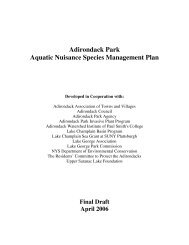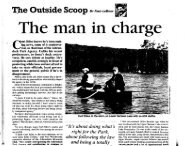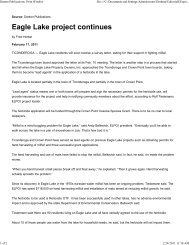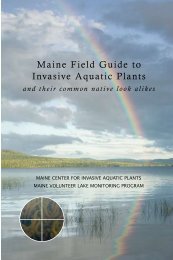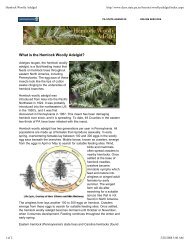SEIS - Eagle Lake Property Owner's Inc.
SEIS - Eagle Lake Property Owner's Inc.
SEIS - Eagle Lake Property Owner's Inc.
You also want an ePaper? Increase the reach of your titles
YUMPU automatically turns print PDFs into web optimized ePapers that Google loves.
AL TERNATIVES ANALYSISThere are basically seven general approaches to the control of rooted aquatic plants, each ofwhich has potential advantages and drawbacks that must be considered in each possibleapplication scenario. Subdivision of these seven approaches provides a considerably longer listof detailed methods (Table 3), but the seven basic approaches remain evident. After adescription of the "No Action" alternative, each plant management approach is outlined and i~sapplicability to the <strong>Eagle</strong> <strong>Lake</strong> milfoil problem is discussed in the following sections.No Action- AlternativeEurasian watermilfoil (milfoil) has not been managed in many of the waterbodies in which itoccurs, mostly out of neglect, but in some cases by intent. In its early to middle stages ofcolonization, milfoil can provide habitat structure of some value to aquatic life forms such as fishand macro invertebrates, at least in contrast to the absence of plants (Pardue and Webb, 1985;Kilgore et aI., 1989). Compared to many native species, however, the value of milfoil is inferior,and its tendency to form very dense growths limits its habitat value in later stages of colonization(Keast, 1984; Nichols and Shaw, 1986). Allowing milfoil to grow uncontrolled has resulted indamage to the native assemblage in most lakes (Madsen et aI., 1991). Additionally, there isdistinct potential for uncontrolled milfoil to provide a source of this plant for other, uninfestedlakes in the region. If Eurasian milfoil infestation can be considered analogous to a disease, theno action alternative represents a failure to take action against a communicable disease amonglakes.In cases where milfoil has been monitored but no action taken, high densities of this plant aretypically achieved within a decade (Carpenter, 1980). Expansion throughout the infested lakecan occur in as little as 2 years (Wagner, pers. obs.), although colonization of all available areasin a very large lake could be expected to take much longer. Once dominant, milfoil populationsappear to fluctuate in an unstable pattern, and in some cases milfoil has declined substantially foruncertain reasons after reaching peak densities in northern lakes (Carpenter, 1980; Painter andMcCabe, 1988; Smith and Barko, 1990; Sheldon, 1995a). Smaller scale or temporary declineshave been noted in many northern areas (Kimbel, 1982; Nichols and Shaw, 1983; Pullman,1992). It has been speculated that observed milfoil declines are linked to factors includingnutrient depletion, decreased light availability, insect or pathogen attacks, or unauthorized use ofherbicides (Carpenter, 1980; Sheldon, 1995a). Insect herbivory has been of great interest in thesedeclines, but despite substantial research in this regard, insect effects remain unpredictable.The no action alternative is not a sound strategy for <strong>Eagle</strong> <strong>Lake</strong>. Lack of action in the mid- to late1980's resulted in considerable expansion of mil foil coverage. Natural declines are not expectedbefore nuisance densities over a large area are reached, and are then unpredictable and not at allguaranteed. The native plant assemblage of <strong>Eagle</strong> <strong>Lake</strong> provides far more habitat value thancould any stage of milfoil growth, and reductions in the native plant assemblage have alreadybeen observed in <strong>Eagle</strong> <strong>Lake</strong>. No benefits, and considerable negative consequences, are expectedunder the no action alternative.D<strong>SEIS</strong> for <strong>Eagle</strong> <strong>Lake</strong> 20 ENSR



